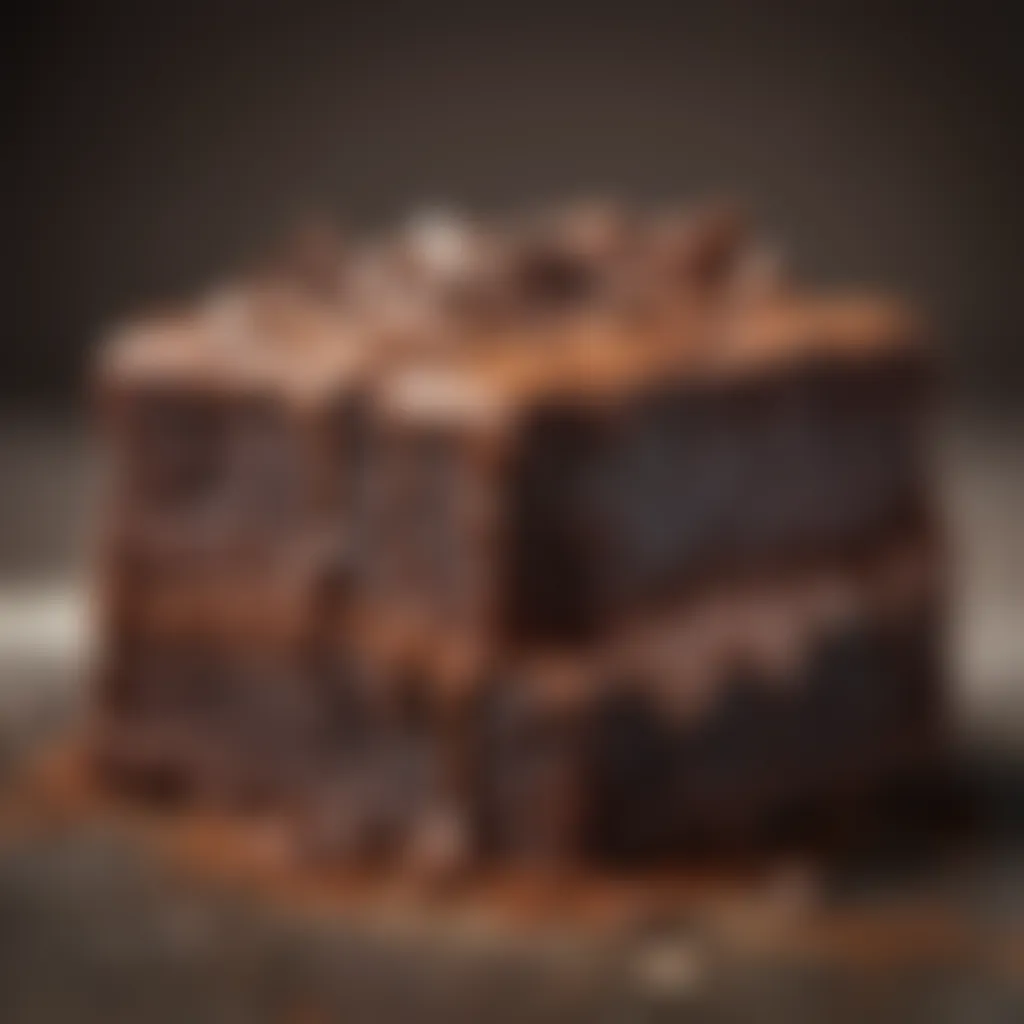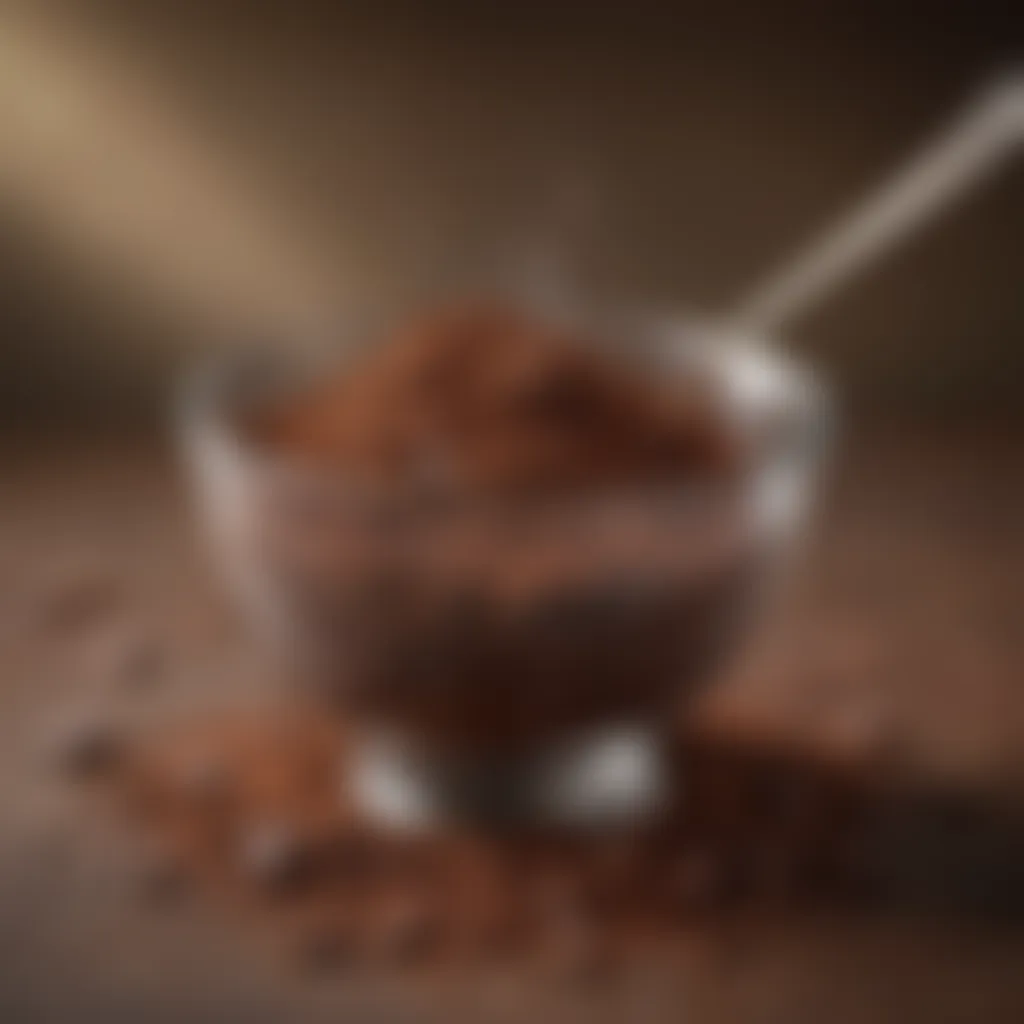Exploring the Depths of Brownies with Hershey Cocoa


Ingredients:
To begin your journey into brownie-making with Hershey cocoa, it is essential to gather all necessary ingredients. This ensures a smooth baking process and enhances the overall flavor of your brownies. Below is a detailed list of ingredients with exact measurements:
- Hershey's Cocoa Powder: 1/2 cup (unsweetened)
- Granulated Sugar: 1 cup
- Brown Sugar: 1/2 cup (packed)
- All-Purpose Flour: 1/3 cup
- Salt: 1/4 teaspoon
- Baking Powder: 1/4 teaspoon
- Butter: 1/2 cup (melted, unsalted)
- Eggs: 2 large
- Vanilla Extract: 1 teaspoon
- Chocolate Chips: 1/2 cup (optional)
- Walnuts or Pecans: 1/2 cup (optional, chopped)
Preparation Steps:
With all your ingredients ready, you can now dive into the preparation process. Follow these detailed instructions with clarity and precision:
- Preheat the Oven: Set your oven temperature to 350°F (175°C).
- Prepare the Baking Pan: Grease or line an 8x8 inch baking pan with parchment paper for easy removal.
- Mix Dry Ingredients: In a medium bowl, combine the Hershey's cocoa powder, granulated sugar, brown sugar, flour, salt, and baking powder. Whisk together until thoroughly blended.
- Combine Wet Ingredients: In a separate bowl, mix the melted butter, eggs, and vanilla extract. Stir until well combined.
- Combine Mixtures: Gradually fold the wet ingredients into the dry ingredients, stirring until just combined. Do not overmix. If desired, fold in chocolate chips or nuts at this stage.
- Pour into Pan: Pour the brownie batter into the prepared baking pan, spreading it evenly.
Technical Aspects:
Understanding the technical aspects of baking brownies will significantly enhance your results. Here are some crucial details:
- Oven Temperature: Maintaining a steady temperature is essential. Ensure your oven is fully preheated before placing the brownies in.
- Baking Time: Bake for approximately 25-30 minutes. Check for doneness by inserting a toothpick into the center; it should come out with a few moist crumbs.
- Cooling Time: Allow the brownies to cool in the pan for about 10 minutes before transferring to a wire rack to cool fully.
Cooking Process:
The cooking process is where the magic happens. Follow these sequential steps carefully:
- Place your brownies in the center of the preheated oven.
- Monitor the baking process closely after the 25-minute mark. This is when most brownies can either undercook or overbake.
- Once baked, remove from the oven and let them cool as indicated above.
Troubleshooting Tips:
Baking can be unpredictable at times. Here are a few troubleshooting tips to address common mistakes:
- If your brownies are dry: This could be due to overbaking or incorrect measurements. Always follow the timing closely.
- If they are too gooey: It might be that the toothpick test was done too early. Put the brownies back in the oven for a few more minutes.
- Uneven texture: Ensure all ingredients are well incorporated and mixed evenly.
"Understanding the baking process and adjusting techniques according to your kitchen environment can lead to perfect brownies every time."
Feel free to adjust ingredients and techniques based on your personal preference once you are comfortable with the basic recipe. Happy baking!
Foreword to Brownies
Brownies hold a special place in the hearts of dessert lovers and bakers alike. This introduction aims to set the stage for the exploration of brownies made with Hershey cocoa, emphasizing their significance in the world of baking. The evolution of brownies, their ease of preparation, and their adaptability to various tastes make them a favorite choice for both novice and experienced bakers.
Understanding the roots of brownies enhances our appreciation for this delightful treat. Each step in the preparation process, from selecting the right ingredients to the final baking techniques, contributes to the unique taste and texture of brownies. Moreover, incorporating Hershey cocoa into the mix elevates the flavor and adds richness that is hard to replicate with other cocoa products.
Historical Background of Brownies
The origin of brownies can be traced back to the late 19th century, believed to have emerged in the United States. Accounts vary on the precise timeline, but it is often attributed to a recipe published in a Boston cooking book in 1896. Some stories suggest that the brownie was created by accident when a chef forgot to add baking powder to a chocolate cake recipe. The resulting dense, fudgy dessert was a hit and led to the brownie as we know it today.
As the decades passed, brownies evolved. They became a staple in many households, popular for their simplicity and versatility. In the early 20th century, various versions appeared, including the introduction of nuts and chocolate chips as common add-ins. The recipe's adaptability allowed it to thrive in different cultures and settings.
Cultural Significance of Brownies in Desserts
Brownies have transcended their humble beginnings to become iconic in the realm of desserts. In American culture, they symbolize home baking and comfort food. Their presence at gatherings and events highlights their importance as a social treat. Whether at birthday parties, bake sales, or holiday celebrations, brownies consistently bring joy and satisfaction.
The cultural significance also extends globally. In many countries, brownies have inspired various interpretations that incorporate local flavors and ingredients. For instance, in Europe, brownies may include unique spices or local chocolates, showcasing regional preferences.
Understanding Hershey Cocoa


The inclusion of Hershey Cocoa in the process of making brownies is significant. It serves not only as a primary flavor element but also influences the texture and overall baking science involved. By understanding the nature of Hershey Cocoa, bakers can better appreciate its role in transforming simple ingredients into a rich and complex dessert.
The Role of Cocoa in Baking
Cocoa is a vital component in many baked goods, especially brownies. It provides depth and character with its unique flavor profile. When baking brownies, Hershey Cocoa contributes to that rich chocolate taste that people adore. This cocoa is processed to produce a consistent taste and high-quality flavor, which is essential for achieving a satisfying result.
The chemical interactions during the baking process warrant attention. Cocoa contains compounds that react with the other ingredients, such as sugar and eggs, creating the desired moisture and density. This interaction helps in the leavening process, ensuring that the brownies rise properly and develop a desirable texture.
In addition, the fat content in cocoa adds richness to the final product. It is crucial to consider the amount of cocoa powder used; too much can make brownies dry and crumbly, while too little can result in a bland flavor. Experimenting with Hershey Cocoa allows bakers to find the perfect balance that suits their taste.
Hershey Cocoa Products Overview
Hershey offers a range of cocoa products suitable for various baking needs. The most common are the unsweetened cocoa powder and the special dark cocoa. Each type serves a distinct purpose in ensuring that your brownies are flavorful and delightful.
- Unsweetened Cocoa Powder: This is the most widely used cocoa in brownies. It has a deep chocolate flavor and is perfect for balancing out sweetness in the recipe.
- Special Dark Cocoa: This is a blend of unsweetened cocoa and Dutch-processed cocoa. It imparts a darker color and a more profound flavor to the brownies. Bakers who want a sophisticated, fudgier taste often reach for this option.
When selecting Hershey Cocoa products, consider the recipe you are using. Each type influences the color, taste, and texture of the brownies differently. By understanding these products thoroughly, you can make informed choices that enhance your baking experience.
Essential Ingredients for Brownies
The choice of ingredients plays a crucial role in the creation of brownies. They are not only essential for flavor but also for the texture and overall satisfaction of the finished product. Understanding what each ingredient contributes allows bakers to make informed decisions and achieve better results. The balance of flavors and textures will ultimately determine the appeal of the brownies.
The Importance of Quality Cocoa
Quality cocoa, specifically from brands like Hershey, significantly influences the flavor profile of brownies. When using cocoa for baking, it is important to choose a product that has a rich taste and provides depth to the dessert. Hershey cocoa is known for its consistent, delicious flavor, making it a popular choice among home bakers.
Other Key Ingredients
Flour Types
The type of flour used in brownies can greatly influence the outcome of the dessert. All-purpose flour is generally the most common choice due to its balanced protein content. This flour type provides the right amount of gluten, resulting in a chewy texture, which many people enjoy in a brownie.
Cake flour, on the other hand, has a lower protein content and can result in a lighter, cake-like brownie. This option is beneficial for those who prefer brownies that are less dense. Each flour type will contribute uniquely to the brownies’ texture, so it is essential to select one that aligns with desired outcomes. Therefore, the choice of flour will shape the ultimately final product.
Sugars and Their Role
Sugars are a fundamental ingredient in brownies, not just for sweetness but also for texture. A mix of granulated white sugar and brown sugar is often used. Brown sugar brings moisture due to its molasses content, helping to create that fudgy texture that many baker's aim for. In contrast, white sugar aids in achieving a slight crust on top, which adds a nice texture contrast.
Understanding how different types of sugar interact is key. It helps in balancing sweetness and achieving the perfect bite. There can be alterations to sugar proportions that may lead to various flavor profiles, making this ingredient crucial for every baker.
Eggs: Size and Function
Eggs are crucial for binding ingredients together in brownies and for providing moisture. The choice of egg size does matter; large eggs are a standard recommendation for most recipes. Their size ensures that enough liquid is added to the batter for proper consistency.
Eggs also contribute to leavening and can influence the texture of brownies. For instance, whisking eggs aerates the mixture slightly, producing a lighter brownie. However, if overmixed, brownies may become tough. This delicate balance is essential to achieve the desired chocolatey delight.
By paying close attention to these components, bakers can enrich the experience of making brownies, leading to a product that delights the taste buds.
The Baking Process
The baking process is a critical stage in making brownies with Hershey cocoa, as it influences both the texture and flavor of the final product. Understanding how heat interacts with the batter and various ingredients is essential. Cooking transforms the chemical makeup of the batter, leading to reactions such as the Maillard effect, which creates a rich flavor profile. This section will analyze key components of the baking process, focusing on batter preparation and the best techniques for achieving the desired outcome.
Preparing the Batter
Creating the batter is the first step in producing brownies. The mixing technique and order of ingredients directly affect the final texture. It begins with adequate measurements; precision is paramount. Using Hershey cocoa imparts a robust chocolate flavor. Combining dry ingredients like flour, sugar, and cocoa in one bowl can help ensure a uniform distribution of cocoa and minimize clumping.


When mixing wet ingredients, such as eggs, melted butter, and vanilla extract, each should be incorporated thoroughly to prevent separation later. Here, using room temperature ingredients can enhance blending.
The next step involves combining wet and dry components. Avoid overmixing, as this can lead to denser brownies. Instead, blend until just combined, leaving some streaks of flour. This ensures a soft, moist texture that many seek in brownies.
"The quality of the batter directly corresponds to the outcome of the baked brownies."
Baking Techniques and Best Practices
Adopting the right baking techniques is crucial for success. First, consider the oven’s preheating. An adequately preheated oven helps achieve consistent baking. Most brownie recipes call for a temperature around 350°F. Using an oven thermometer ensures accuracy, as home ovens often vary.
When it comes to the baking dish, metal pans are preferable for brownies. They conduct heat better than glass, allowing for a more even bake. Greasing the pan is another critical step; this prevents sticking and allows for easy removal once cooled.
Check for doneness carefully. Brownies can go from perfect to overbaked rapidly. A toothpick inserted in the center should come out with a few moist crumbs clinging to it but not wet batter. Underbaking slightly can ensure a fudgy texture.
Lastly, consider cooling time before serving. Allowing brownies to cool in the pan for about 10-15 minutes, followed by transferring to a wire rack, helps enhance the flavor as they set. The cooling process lets the brownies develop their structure entirely while making them easier to cut.
By mastering this baking process, you ensure the brownies made with Hershey cocoa are not just good but exceptional.
Customizing Your Brownies
Customizing your brownies allows for a unique expression of taste and creativity. Each add-in or alternative recipe provides different characteristics and textures. This is important because not all palates are the same, and personalizing brownies ensures that everyone can enjoy this classic treat. Furthermore, customization can enhance nutritional value, cater to dietary restrictions, and elevate the overall experience.
Add-ins for Enhanced Flavor
Nuts and Their Variations
Incorporating nuts into brownies can significantly elevate their flavor and texture. Nuts add a crunchy contrast to the fudge-like base that brownies are known for. Almonds, walnuts, and pecans are popular options. The presence of nuts not only provides a delightful crunch but also infuses a nutty undertone that complements the rich cocoa flavor of Hershey's cocoa. Additionally, nuts are a source of healthy fats which contribute to overall well-being. However, one should be cautious when using nuts, as they can lead to allergies for some individuals. Therefore, it is essential to know your audience when deciding to include them in your brownies.
Chocolate Chips
Adding chocolate chips into brownie batter is a common practice that many bakers adore. The chocolate chips melt during baking, creating pockets of gooey chocolate throughout the brownie. This enhancement intensifies the flavor profile. Semi-sweet or dark chocolate chips are often favored, as they contrast well with the sweetness of the brownie. Their ability to add another layer of chocolate flavor makes them a beneficial choice for enriching the overall dessert. Nevertheless, using too many chocolate chips can sometimes lead to an overly sweet brownie. Balancing the amount used is crucial to achieve the desired flavor without overwhelming the palate.
Fruits and Spices
Fruits, such as raspberries, cherries, or even bananas, can be integrated into brownie recipes for a delightful twist. They add moisture and a natural sweetness, which can reduce the need for added sugar. Spices, like cinnamon or nutmeg, can introduce warmth and depth to flavor. These choices are beneficial for those looking to create a more health-conscious dessert. However, both fruits and spices slightly alter the texture, making brownies less dense than traditional recipes. This is worth considering, as the classic brownie texture is what many expect.
Alternative Recipes with Hershey Cocoa
Vegan Brownies
Vegan brownies are an excellent choice for those who avoid animal products. They use substitutes such as applesauce or flaxseed meal instead of eggs, which helps maintain moisture and structure. Using Hershey cocoa ensures that the rich chocolate flavor remains intact. Vegan brownies cater to a growing demographic interested in plant-based diets. However, they occasionally require careful measurements to avoid a gummy texture.
Gluten-Free Options
Gluten-free brownies can be made using almond flour or gluten-free all-purpose flour. This allows those with gluten sensitivities to enjoy brownies without worry. The use of Hershey cocoa stays consistent, delivering the same indulgent chocolate flavor. Gluten-free baking can have its challenges, such as achieving the proper texture, which often means experimenting with ratios and combinations of flours.
Sugar-Free Solutions
For those looking to reduce sugar intake, it's possible to make brownies using sugar alternatives like stevia or erythritol. These substitutes can maintain sweetness without the added calories of sugar. Using Hershey's cocoa ensures that the chocolate flavor is still prominent. However, the challenge lies in finding the right balance; too much sugar substitute can lead to an aftertaste that many may find unappealing.
Customizing brownies opens the door to numerous possibilities, catering to various preferences and dietary needs. Through thoughtful consideration of flavors, ingredients, and alternatives, any baker can create a personalized brownie that delights.
Evaluating Texture and Flavor
Understanding the texture and flavor of brownies is crucial in creating these beloved desserts effectively. Brownies stand out not only for their rich taste but also for the satisfying mouthfeel they provide. The interplay of various ingredients during the baking process significantly impacts the final product. By evaluating texture and flavor, bakers can refine their recipes, leading to enhanced enjoyment and satisfaction in every bite.


The Science Behind Texture
Texture in brownies is influenced by the balance of ingredients and the baking method. Key elements include fat content, flour type, and baking time. Each component plays a vital role. For example, the use of unsweetened Hershey cocoa adds richness but also affects moisture.
Baking soda or baking powder contributes to the rise and creates a softer texture, while the fat, whether butter or oil, determines how fudgy or cakey the brownies become. The ratio of wet to dry ingredients is fundamental as well. Too much flour can yield a dry finish, while too little may lead to excessive gooeyness.
To achieve the desired texture, consider the following:
- Fat Type: Butter provides a rich flavor, while oils may produce softer brownies.
- Mixing Method: Overmixing can lead to tougher brownies, while gentle folding maintains softness.
- Baking Time: Underbaking results in a fudgy brownie, whereas baking a bit longer creates a cakier texture.
Flavor Profiles in Brownies
When discussing flavor in brownies, Hershey cocoa acts as a pivotal ingredient. Its deep chocolate flavor, along with sugar and other additives, creates a well-rounded taste experience. Different flavor notes emerge based on various elements added during preparation.
Important aspects to consider in flavor include:
- Cocoa Quality: Higher-quality cocoa, like Hershey's, offers intense flavor, influencing the overall taste.
- Sugars: Different types of sugar can result in varying sweetness and caramel notes. For example, brown sugar imparts a deeper flavor due to its molasses content.
- Add-ins: Including chocolate chips, nuts, or spices can elevate the complexity of flavors found in brownies. Each component introduces new taste sensations, enriching the culinary experience.
By understanding how texture and flavor work together, bakers not only appreciate the science behind brownie-making but also attain the skills needed to customize recipes, ensuring delightful outcomes.
Storage and Serving Suggestions
Proper storage and serving of brownies is essential to ensure that their delightful flavor and texture remain intact. Brownies are sensitive to environmental conditions, which means that their storage can greatly influence their taste and quality. Understanding how to store and serve them properly can elevate a simple treat into a memorable dessert experience. By considering aspects like humidity, temperature, and serving methods, bakers can prolong the life of their brownies while enhancing the overall enjoyment for those who indulge.
Optimal Storage Techniques
To keep brownies fresh and flavorful, it is crucial to follow certain storage recommendations. Here are a few guidelines to consider:
- Cool Completely Before Storing: Allow your brownies to cool completely before wrapping or covering them. This prevents condensation from forming, which can lead to sogginess.
- Use an Airtight Container: Store brownies in an airtight container to minimize exposure to air. This helps maintain moisture and prevents them from becoming dry.
- Refrigeration: While room temperature is generally best, if your climate is humid or hot, refrigeration may be necessary. Just be aware that chilling can alter the texture slightly, making them less fudgy.
- Freezing for Long-term Storage: If you want to keep brownies for an extended period, consider freezing them. Wrap individual portions tightly in plastic wrap and then place in a freezer-safe bag. They will last up to three months in the freezer.
- Thawing: When ready to enjoy, thaw frozen brownies in the refrigerator overnight or at room temperature for a couple of hours.
Storing brownies properly retains their rich flavor and soft texture, making your baking efforts worthwhile.
Pairings and Presentation
Serving brownies is as important as making them. Thoughtful pairings and attractive presentation can enhance the overall dessert experience. Here are some ideas to consider:
- Classic Pairings:
- Presentation Ideas:
- Ice Cream: A scoop of vanilla or mint chocolate chip ice cream complements the rich chocolate flavor beautifully. The cold ice cream against the warm brownie creates a delightful contrast.
- Whipped Cream: Light and fluffy whipped cream can add a soft texture to the overall dish. Consider adding a hint of vanilla for extra flavor.
- Fruits: Sliced strawberries or raspberries add freshness and acidity, balancing the richness of the brownie.
- Layered Desserts: Create a dessert parfait by layering brownies, ice cream, and whipped cream in a glass. This allows for a beautiful visual as well as diverse textures in each spoonful.
- Dusting: Sift powdered sugar or cocoa powder over the top for an elegant finish. Shaving dark chocolate on top can also enhance both the appearance and flavor.
- Plating: Serve brownies on a decorative plate with a drizzle of chocolate sauce or caramel sauce. The visual appeal adds to the overall enjoyment of the dessert.
By focusing on thoughtful storage and creative presentation, bakers can enhance the delight found in each bite of brownies. These practices turn a simple dessert into a memorable experience.
End and Final Thoughts
In summarizing the exploration of brownies made with Hershey cocoa, it is essential to recognize the multifaceted importance of the journey through taste, technique, and tradition. This article has provided both novices and seasoned bakers with a comprehensive understanding of what makes brownies a beloved dessert. The foundational elements discussed highlight the significance of selecting high-quality ingredients, proper techniques, and the unique characteristics that Hershey cocoa brings to the baking process.
The Enduring Appeal of Brownies
Brownies hold a special place in the hearts and kitchens of many. Their rich flavor and fudgy texture evoke nostalgia and comfort. Understanding their enduring appeal involves recognizing their versatility. Brownies can easily adapt to various occasions and personal tastes. Whether served at a family gathering or baked for a quiet evening at home, their simplicity allows for endless reinterpretation. Furthermore, some might consider brownies a canvas for creativity. The rich, chocolatey base invites numerous add-ins, from nuts to spices, offering something unique for every palate.
The cultural significance of brownies cannot be understated. They are often a staple at bake sales, potlucks, and celebrations. Their accessibility, requiring only basic ingredients, makes them achievable for any home cook. This communal aspect fosters a sense of connection for those who share them.
Encouragement for Experimentation
Encouraging experimentation is critical for anyone embarking on their brownie-making adventure. While traditional recipes are a solid starting point, the real joy lies in adapting those basics to fit one's preferences. For example, incorporating alternative sweeteners can appeal to health-conscious bakers. Likewise, using Hershey cocoa in different forms—such as dark cocoa or special dark—can create varied flavors and textures.
Baking should be seen as an exploratory process. Trying different flavor combinations like adding a hint of espresso or even a swirl of peanut butter can lead to unexpected and delightful results. Engaging with the process opens the door to personal growth in the culinary arts.
Consider also the opportunity to learn from others. Sharing experiences and techniques within communities can enhance skills. Resources like Reddit or Facebook groups provide avenues to exchange ideas and gain inspiration.





